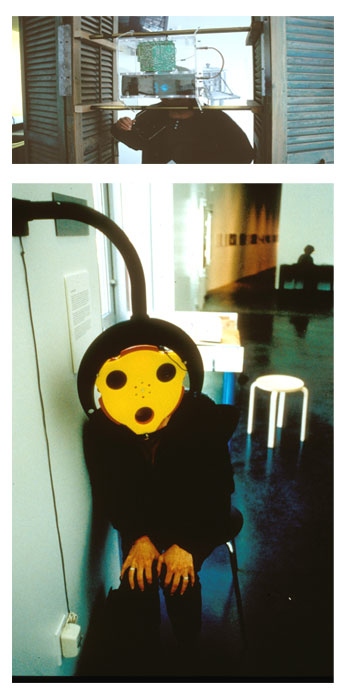
Bellevue Art Museum
Seattle, Washington
“The bodily eye sees all objects outside itself, but needs a mirror to see itself”
– Giambattista Vico, The New Science of Giambattista Vico 1744
Designing the Bellevue Art Museum, architect Steven Holl was charged with emphasizing and creating space for an artist residency, projected to be a hallmark of the new museum. Donald Fels was invited to inaugurate the residency program and was named artist in residence for the museum’s first year of operation. In response to “Luminous”, the museum’s initial exhibition, Fels put together a team to consider the act of seeing in a museum. His collaborators consisted of Ed Mannery, optics engineer, and performers the Climax Golden Twins (Rob Millis and Jeffrey Taylor). He named the group Voluntary Observers (V.O.), after a practice historically employed by the United States Weather Service to get informed reports on area climate.
Over their months in the museum, the group created four installations to consider aspects of looking at the museum, each of which evoked and/or triggered sound and light in response to visitors and artwork. For an installation created with a room sized painting by Mary Henry, V.O. explored the potential in optic fiber networked into the building, ‘borrowing’ sound from one part of the museum and ‘relocating’ it into another gallery. The “Flavinscope”, a personally sized viewer was aimed at a Dan Flavin sculpture – allowing the visitor to change the color and sound pitch given off by the florescent piece.
Installed to look out on the roofscape was their version of a cyanometer: an instrument for measuring and comparing the color intensity of the sky. Fels researched the original instrument designed by Horace-Benedict de Saussure and used on an expedition by Alexander von Homboldt. In the artist residency studio, they created a looking device that employed a video camera to project the viewer’s eye movements back to the viewer, as s/he looked out at an adjoining gallery. The device offered museum visitors a glimpse of their own looking.
Fels has long been interested in how we experience space, how we see ourselves and others in relationship to our surroundings. The residency at BAM functioned as a laboratory where perception could be researched and experimentated with. Fels wanted visitors and curators alike to confront the museum as a field that changed with visitor interaction. As V.O. considered the act of looking at the museum, Fels met with the museum staff to discuss how artist residencies could alter exhibitions in-situ.


